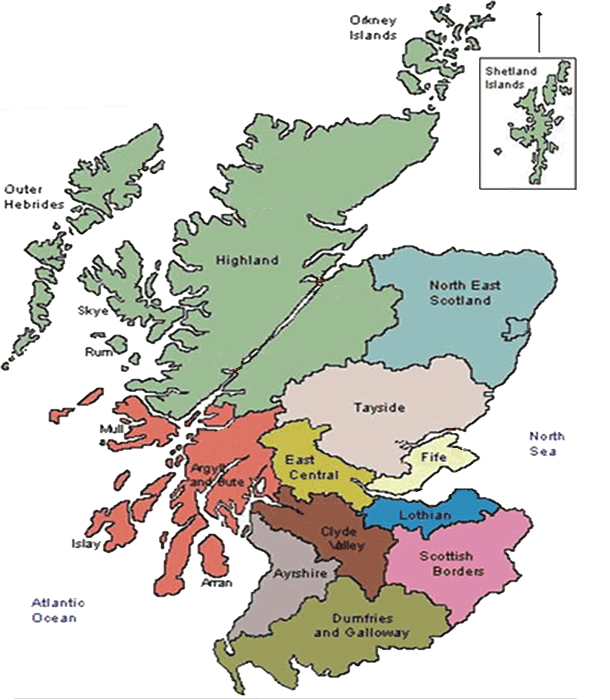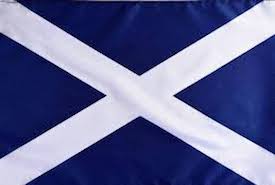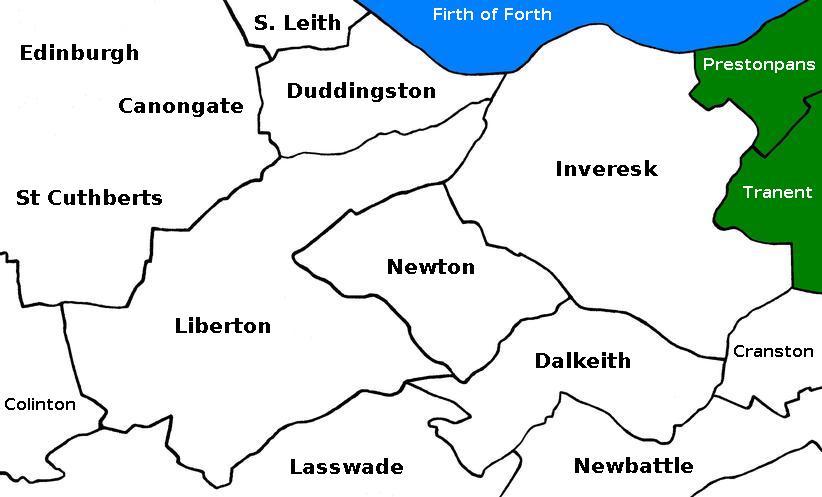


It has always been assumed that our particular Jameson family, has is beginnings (as Jam?sons ) in Scotland. Many have speculated about this, as to who, when and where, but no proof of this has ever been found to substantiate anything. Although almost all of the earliest Jamesons in our family, that we can substantiate, have all thought to have emigrated from Ulster, Ireland, at one time or another. It is however, generally accepted that before our Jamesons were in Ireland, they were almost certainly from Scotland. Inevitably we can expect to discover some of our Jam?son families that did not actually ever migrate into (and out of) Ireland, but are directly from perhaps, England, Wales, or of course Scotland itself. Nevertheless, it can be pretty much assumed that all of our Jam?sons originally came from Scotland. In fact, some Jam?sons directly related to us now, may still be living in Scotland. Trying to figure out who and where our particular ancestors were in Scotland, prior to Ulster, is however not an easy task. Although record keeping in Scotland prior to 1700 was much better than the records (or lack thereof) we are faced with in Ulster, but even so, none of either is like it is today or even for the last two hundred years, in the UK. Part of the problem is we do not really always know who we are looking for, or really where to look. Furthermore, much of what we have not been able to figure out about our Jam?sons in Ulster, hinders what to look for in Scotland.
But it is more than that. The biggest difficulty with finding early ancestors in Scotland, is that records were rarely kept at all, prior to the mid sixteenth century and were scarce, incomplete and unreliable at that. Even during the seventeen century, not all of Scotland was compliant. Furthermore, surnames were not used reliably until at least the sixteenth century and even then not in all areas, like especially in the islands. Finding ancestors back to the early 1600's is about as good as it gets for most people, anything else is quite rare and often just pure luck.
Nowadays, we have the advantage of using modern technology, particularly internet access to far-flung records and DNA analysis, for help with situations such as this. However, DNA only works with people who have tested, which is not yet done by enough Jam?sons as is needed to be really useful. What DNA testing that has been done, seems to suggest, at least in an anthropological sense, that our connections with even earlier Jam?son families might be in the northeast areas of Scotland, areas from about the Edinburgh area northeastward into Aberdeenshire, all the way to the Moray Firth and beyond, the outer islands and even perhaps into Scandinavia. These would be very distant relatives, where shared connections are way older than when surnames were used or any kind of official records kept.
However, having said that, we have more recently come across some more official Scottish records in the seventeenth century that show a Jamisone family in the Edinburgh area of Midlothian, we believe is our connection with at least some of our early Jam?son family, in Scotland. It is a family of Jamisones, all born in the 1600s, who pretty much fit with some of our Jamesons we already know about in Ulster, Ireland, from in the late seventeenth and early eighteenth century, including some of those who emigrated from Ireland to New Hampshire. This Scottish Jamisone family is itself extended, yet the details seem to suggest they all fit together, taking them, and thereby us, all the way back to the early 1600s and even maybe a little earlier. They then pretty much disappear from that area soon after the early 1700s, just as you would expect them to, if as an example they had migrated to Ireland or beyond. Not only that, amongst these Scottish Jamisones were many ministers, at least one outspoken (and punished), with Presbyterian sensibilities, during a difficult time for that, a time specifically known for persecutions and migrations of oppressed Presbyterians, often fleeing both Scotland and Ireland. Our Jamesons, the ones we know about in Ireland and New England, during that time, were known to be a part of this issue and the situation of this Jameson family in Scotland, before that, is a perfect fit and seamless continuation, not just with a convenience of names and dates, but also with the political and religious issues of those times and places.

 It appears our oldest known Jam?son ancestors in Scotland were all from the area of Inversek and Musselberg, in eastern Midlothian, Scotland, not far from Edinburgh. We believe they are all descended from a Edward Jamesone, Burgess of Musselburgh, probably born about 1550 and died there about 1624. Details given in the 1741 New Hampshire will of Jonathan Jameson identify various members in his family, both in Ireland and in New Hampshire, establishing the roots of our family. Both he and his brother Edward have long been believed to have been likely born in Scotland and they (along with many others) emigrating to Ulster Ireland, during these difficult times in Scotland. Especially given that their father was a Presbyterian Minister, politically active during these period (see below). Of those Jonathan identified, he and his brother Edward can be found in records of the Inversek family of Edward and Magdalene (Keir) Jamisone. From this we can assume all others connected with them are our family as well. Without DNA triangulation however, this and any connections between these two families are at this point still somewhat speculative, nevertheless circumstantially quite persuasive. The father of this Scottish family, is Edward Jamisone born in 1624 to George and Marion (Thomson) Jamesone. This elder Edward's siblings were, Alexander, William, George, Johne, Margaret, Helene, Alisoune, George and Marion. Again, many of those names, particularly Alexander, are known to us in Ulster and again in New Hampshire, from Jonathan's 1741 will. We believe this Alexander could be the father, or maybe grandfather of our Hugh and Thomas Jameson in Ulster. Although there is no official or verifiable records for any of this, we feel these details speak for themselves and both explain and substantiate our connection. Again, this is all understandably somewhat circumstantial and speculative, but very plausible, persuasive and quite likely. We can also assume that many other of those in this area at that time with the Jam?son surname may very likely also be part of our Jameson family. Unfortunately we have not been able to figure them out, at least not yet.
It appears our oldest known Jam?son ancestors in Scotland were all from the area of Inversek and Musselberg, in eastern Midlothian, Scotland, not far from Edinburgh. We believe they are all descended from a Edward Jamesone, Burgess of Musselburgh, probably born about 1550 and died there about 1624. Details given in the 1741 New Hampshire will of Jonathan Jameson identify various members in his family, both in Ireland and in New Hampshire, establishing the roots of our family. Both he and his brother Edward have long been believed to have been likely born in Scotland and they (along with many others) emigrating to Ulster Ireland, during these difficult times in Scotland. Especially given that their father was a Presbyterian Minister, politically active during these period (see below). Of those Jonathan identified, he and his brother Edward can be found in records of the Inversek family of Edward and Magdalene (Keir) Jamisone. From this we can assume all others connected with them are our family as well. Without DNA triangulation however, this and any connections between these two families are at this point still somewhat speculative, nevertheless circumstantially quite persuasive. The father of this Scottish family, is Edward Jamisone born in 1624 to George and Marion (Thomson) Jamesone. This elder Edward's siblings were, Alexander, William, George, Johne, Margaret, Helene, Alisoune, George and Marion. Again, many of those names, particularly Alexander, are known to us in Ulster and again in New Hampshire, from Jonathan's 1741 will. We believe this Alexander could be the father, or maybe grandfather of our Hugh and Thomas Jameson in Ulster. Although there is no official or verifiable records for any of this, we feel these details speak for themselves and both explain and substantiate our connection. Again, this is all understandably somewhat circumstantial and speculative, but very plausible, persuasive and quite likely. We can also assume that many other of those in this area at that time with the Jam?son surname may very likely also be part of our Jameson family. Unfortunately we have not been able to figure them out, at least not yet.
Scotland and Ireland were very difficult places, as was England, during the seventeenth century. It was a time before Scotland and England united and many years more until Ireland became part of that group. This was a time of the Reformation in these areas, and a time of the Covenanter in Scotland. The Scottish Reformation was the process by which Scotland broke with the Papacy and developed a predominantly Calvinist national Kirk, which was strongly Presbyterian in outlook. It was part of the wider European Protestant Reformation that took place beginning from the sixteenth century. The Reformation resulted in major changes in Scottish society and culture. The Reformation throughout the entire British Isles was not a peaceful revolution either, with significant upheavals included the "War of the Three Kingdoms" from 1644-1651, basically simultaneous civil wars in these three countries. In May of 1660, Charles II returned from exile in Holland and the monarchy was restored to him. The Scottish Parliament met in January of 1661 and over the next weeks all previous laws and covenants passed after 1633, including the highly cherished National Covenant, were repealed and all power was given to King Charles II. This included making him the head of the Church of Scotland. He quickly abolished the Presbytery and appointed Episcopal bishops who answered to him. While Presbyterians were quite willing to acknowledge the King as the head of the civil government, they strongly believed that Christ was the head of the Church and they would not accept King Charles in that capacity. Those ministers who would not comply with the new Episcopal establishment and liturgy were forced out of their pulpits and replaced. These "outed" ministers began holding services, called conventicles, for their like-minded parishioners in homes and fields. King Charles' government declared the conventicles illegal and passed a series of laws with ever-increasing penalties for preaching, performing marriages or baptisms or even attending the now-secret meetings. The ministers incurred the most severe penalties which could include fines, imprisonment and the loss of a limb. Some ministers fled to Ireland, Holland, or other safer places and some of those returned later to Scotland to help in their cause. Other ministers remained in Scotland, hiding from the authorities while continuing their ministries in secret. Not surprisingly the heart of the movement in Scotland was centered in Edinburgh.
The Edward, son of George (above), who we know was born in the Inveresk and Musselburgh area, died in 1704 We also know he graduated from Edinburgh University in 1643 and was ordained a minister in the Church of Scotland about 1647. He was the Minister at Swinton in Berkshire from 1647-1661, when he was disposed from the church, punished for his defiant activities as they related with the newly forbidden Presbyterian issues, explained above. Eventually Edward was reinstated a minister in 1687, when the Declaration of Indulgence or Declaration for Liberty of Conscience was issued for Scotland by King James VII. It allowed people the right to worship where and how they chose and abolished the penal laws requiring religious conformity. That was followed by the restoration of the Presbytery within the Church of Scotland in 1689-90. He first returned as minister in Swinton and was then the Minister at Monimail in Fife, from 1690 until the time of his death in 1704, and where he died. We also know that he married a Katherine Coneltoune/Congliton in 1672, in Haddington, East Lothian, Scotland, with whom he had three children, William, George (who was also a minister) and Grace, presumably all born in Haddington. We assume the Edward who married Magdalen Keir and had the six children during the 1660s, is that same Edward born in the Inveresk and Musselburgh area, given the timeline and location of all other activities of that family and given that we can find no records or mention of any other Edward Jamesone at that time in that area. It is a logical conclusion, yet it is not one with which we have any concrete proof.
We also have evidence that an Alexander Jamiesone of that era and place, was a minister, who we believe was the Alexander, brother of Edward (1624-1704) and of a William Jamesone (same era and place), but who we cannot determine was also a brother.
It is our theory and opinion that this seventeenth century Jamesone family from the Midlothian area of Scotland, is an excellent and likely fit, to be the ancestral family of the Jameson family of Ulster, Ireland we know to be our forefathers and assume the ancestors of other Jameson families, yet unknown. Further research will be necessary to either confirm or disprove these beliefs. So for now, the discovery can only be considered a persuasive probability.
It should also be noted, that even if our theory on this is true and that these Jamesones are directly connected with our family, we don't know exactly how they would be connected. We think the children born to Edward and Magdalen in the 1660's include the Jonathan who died in 1741 in New Hampshire and named a brother Edward, who's son John was living in Dumbrough area of County Londonderry, Ulster, at that time. We don't however know how our Ulster ancestors Hugh and Thomas fit into this picture, but we do know they are related because they are referred too as "cousins" in Jonathans1741 will. We think they are likely descended from the other children of George and Marion Jamesone, siblings of that Edward (1624), father of the Edward and John, born in the 1660s. That whole part is also based in conjecture and will need further study.